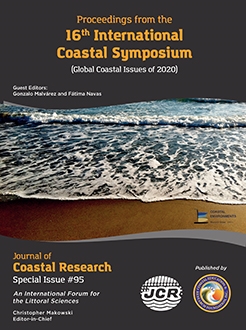Woo, H.J.; Lee, J,-H.; Choi, J.U., and Kang, J., 2020. Changes in sedimentary processes in macrotidal flats in Garolim Bay, West Coast of Korea. In: Malvárez, G. and Navas, F. (eds.), Global Coastal Issues of 2020. Journal of Coastal Research, Special Issue No. 95, pp. 722-726. Coconut Creek (Florida), ISSN 0749-0208.
Garolim Bay, on the central western coast of Korea, is a semi-enclosed macro-tidal bay with extensive tidal flats that occupy approximately 77% of the bay surface area. The study investigated the sediment characteristics and sedimentation rates to elucidate the spatial and temporal variations in the sedimentary processes in the bay. Surface sediments were sampled to grain-size distributions at 158 stations in July 2002 and July 2014 in the spring tidal cycle. Grain-size distributions were analyzed using standard sieving for the sand fraction and a particle size analyzer for the mud fraction. The geomorphic changes associated with sediment deposition or erosion were investigated along six transect lines on the tidal flats from February 2014 to February 2015 in the ebb tide. The area of sand and muddy sand sediments had extended from the outer to the middle bay in summer 2014, and the percentages of mud were higher in the inner bay compared to the surface sediment distributions in summer 2002. The short-term sedimentation rates from February 2014 to February 2015 showed that erosion was dominant on the tidal flats in the inner bay during spring and on those in the outer bay during winter, with net erosion rates of –1.55 and –55.23 mm/year, respectively. In the middle bay, deposition dominated on the tidal flats, with net deposition rates from 4.85 to 18.94 mm/year. The sediment transport vectors calculated using grain-size parameters for 2002 and 2014 showed that in 2002, sandy sediments were predominantly transported along tidal channels at the bay entrance. However, in winter, sediments from the tidal flats in the outer and middle bay areas are transported to the inner bay by wind-driven waves and tidal currents, resulting in the deposition of sediment on the tidal flats in the inner bay. In summary, the results show that the sediment transport patterns in Garolim Bay changed between 2002 and 2015 due to increased suspended sediment supply and erosion of the tidal flats in the outer bay. Based on these knowledge of sedimentary processes, the major control factors for seasonal variations in sedimentation on the tidal flats in Garolim Bay are tidal currents, wind-driven waves, and sediment inputs.





